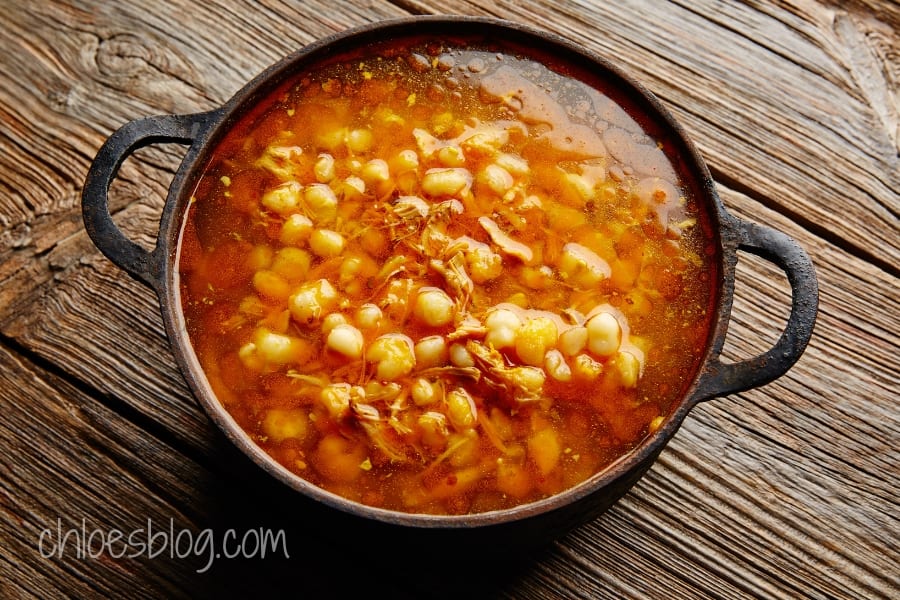Last week, I feasted on an absolutely delicious posole. If you aren’t familiar with this hearty soup, you are missing out. It is a main course dish that consists of pork, onions, garlic, dried chiles, hominy and cilantro that simmers together in broth.
Traditionally, it was served at Christmas and comes to us from Mexico’s Pacific coast area. As I savored each bite, I was reminded of how very much I love regional foods and especially hominy. Posole and hominy are the same thing. The name hominy comes from the Algonquian word “rockahominy.”
I grew up with hominy served as a frequent side dish with pork. In the South, that was common years ago and to have it pulled together in a soup is genius. Hominy is an overlooked item at the grocery store. As evidence, the last time I purchased it at the supermarket the store clerk asked me what it was.
Hominy is made by soaking whole kernel corn in a lime solution in order to remove the hull and germ. After soaking, it is rinsed and then either canned or dried and sold in that form. Dried hominy has to be reconstituted (like dried beans) before using in recipes. If it is ground, it is sold as grits.
Although uniquely colored corn can be used to make hominy, the corn most often used is either white or yellow. And that color is how it is sold canned and found in on the shelves near the canned corn. I like to buy one of each to mix them together for a beautiful side enhanced with just butter and black pepper.
One of the things I’ve been doing for years is using hominy in the place of whole kernel corn in recipes. It changes the look, texture and taste of the recipe in an interesting and tasty way.
Hominy is nixtimalized corn that has been treated with cal to release the vitamin niacin, making the grain healthier and easier to digest. Here’s how to cook hominy, also called posole. Our white corn posole/prepared hominy is the subject of one of the most confusing name systems in English and Spanish.

If you’ve ever had a corn tortilla or a tamale, you’ve eaten nixtamalized corn. And if you’ve ever eaten posole, you’ll never look at a can of hominy the same way again, or make fun of your buddy for keeping some in the cabin.
Cook for another hour and add the zucchini and chile slurry. Continue cooking for another half hour or so.
I put carrots and zucchini on the ingredient list as optional because they aren’t part of a traditional posole. But I like the flavor and color they contribute. If using these, add the carrots along with the meat and onions.
Adjust water level to your desired proportion of broth to chunks. I recommend keeping it on the brothy side. Add salt to taste. (I actually like the taste of a little soy sauce in there, too). Simmer for 15 minutes, season again, if necessary, and serve.
When the meat is approaching tender, begin cooking the posole corn (either the soaked, dried posole, or the frozen or canned) in six quarts of water.
Traditionally, it was served at Christmas and comes to us from Mexico’s Pacific coast area. As I savored each bite, I was reminded of how very much I love regional foods and especially hominy. Posole and hominy are the same thing. The name hominy comes from the Algonquian word “rockahominy.”
Rye flour doesn’t have as much gluten as all-purpose flour, so it will give you a dark, heavy result. Since it doesn’t rise as well when making bread, it is usually combined with flours that are higher in protein. I love it when used as a binder in meatloaf or meatballs.
Last week, I feasted on an absolutely delicious posole. If you aren’t familiar with this hearty soup, you are missing out. It is a main course dish that consists of pork, onions, garlic, dried chiles, hominy and cilantro that simmers together in broth.
One of the things I’ve been doing for years is using hominy in the place of whole kernel corn in recipes. It changes the look, texture and taste of the recipe in an interesting and tasty way.
Hominy is made by soaking whole kernel corn in a lime solution in order to remove the hull and germ. After soaking, it is rinsed and then either canned or dried and sold in that form. Dried hominy has to be reconstituted (like dried beans) before using in recipes. If it is ground, it is sold as grits.
Rick Bayless: What is Pozole Corn and Calcium Hydroxide?
FAQ
Are pozole and hominy the same?
What are the 3 types of pozole?
Does canned hominy need to be rinsed?
What is pozole made of?
Pozole is a Mexican culinary institution that can be traced back thousands of years. The main ingredient, hominy, was considered to be the most important crop in the ancient Mesoamerican world. Hominy is made by shelling corn kernels and submerging them in a mixture of water and lime so they soften and become enlarged.
Where does Hominy come from?
Hominy comes from yellow or white maize, also known as field corn. Dried hominy kernels are soaked in an alkali solution of lye or slaked lime. This process, called nixtamalization, removes the hull and germ, making the corn easier to grind and cook with.
How was hominy made?
Hominy is made by shelling corn kernels and submerging them in a mixture of water and lime so they soften and become enlarged. Corn was considered a sacred plant by the Aztecs, so pozole was enjoyed only on the most special occasions, i.e. the ritual sacrifice of Aztec enemies.
What is pozole?
Pozole is a classic Mexican corn stew which comes in three main varieties that are all very different from each other.
